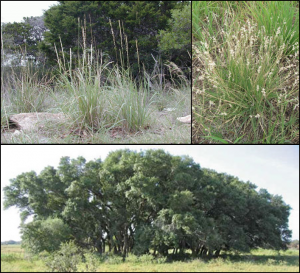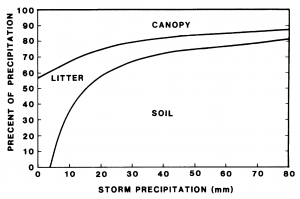5.2 Rainfall Interception
In many terrestrial environments, before water inputs from rainfall or irrigation ever reach the soil surface, the vegetative canopy and plant residue alter both the amount and spatial distribution of those inputs. When rainfall is prevented from reaching the soil because of interception by plant canopies or plant residue and subsequent evaporation, that process is called rainfall interception. Related process include: throughfall, when rain passes through the canopy before reaching the soil; stemflow, when rain striking the plant canopy flows down leaves and branches to the main stem of the plant and flows down the stem to the soil; and canopy drip, when water from rain or dew drips off the outer edges of the plant canopy. Similar interception processes can occur when water inputs are supplied by sprinkler-type irrigation systems. These interception processes can strongly affect the soil water balance in both natural and managed ecosystems, and the magnitude of the effects are illustrated by the following case study.
5.2.1 Vegetation Characteristics Affecting Rainfall Interception
Soil water availability is typically the limiting factor for vegetative productivity of the expansive rangelands on the Edwards Plateau in central Texas, USA. Dominant species of vegetation in these rangelands include: sideoats grama [Bouteloua curtipendula (Michx.) Torr.], a bunchgrass; curlymesquite [Hilaria belangeri (Steud.) Nash] a shortgrass; and live oak (Quercus virginiana Mill.), a broadleaf, evergreen tree [10]. These species have different growth habits as illustrated in Fig. 5‑6, and as a result, rainfall interception differs between the species.
Using a combination of field and laboratory measurements, researchers discovered that curlymesquite canopies intercepted more rainfall than sideoats grama in this environment on a per unit mass basis because curlymesquite has flat leaf blades covered with fine hair and also stolons, which grow horizontally at the soil surface [10]. These characteristics made curlymesquite relatively effective at intercepting rainfall. However, sideoats gramma intercepted more rainfall than curlymesquite on a per unit area basis because the mass of standing live and dead biomass was greater in sites dominated by sideoats grama than in sites dominated by curlymesquite.

The maximum volume of rainfall per unit area that a particular plant canopy can hold is the interception storage capacity of the canopy. For the sideoats grama-dominated site the interception storage capacity was 1.8 mm compared to 1.0 mm for the curlymesquite-dominated site. Based on the observed size distribution of rainfall events in the region, 18.1% of annual rainfall would be intercepted at the sideoats grama-dominated sites, compared with 10.8% at the curlymesquite dominated sites.
These interception totals are certainly enough to reduce water availability, but they were far exceeded by the rainfall interception of the clumps, or mottes, of live oak. In the live oak mottes, the canopy was dense, and the soil surface was covered by a thick accumulation of leaf litter. The live oak leaf litter could hold approximately twice as much rainfall per unit mass as the grasses and had an estimated interception storage capacity of 8.7 mm. Thus, the canopy and the leaf litter together were highly effective in rainfall interception, and only 53.9% of the annual precipitation reached the soil (Table 5‑2).
Table 5‑2. Partitioning of annual rainfall within live oak mottes based on 10-year average rainfall event size distribution for a site on the Edwards Plateau in central Texas, USA. Adapted from Thurow et al. (1987).
| Amount | Percent of Annual Rainfall | |
| mm | % | |
| Annual Precipitation | 523 | |
| Canopy Interception | 133 | 25.4 |
| Throughfall + Stemflow | 390 | 74.6 |
| Litter Interception | 108 | 20.7 |
| Water Reaching the Soil | 282 | 53.9 |
Although stemflow accounted for only 3.3% of annual precipitation, stemflow delivered a volume of water equivalent to 222% of the annual precipitation to the soil within a 10-cm radius of each tree. This redistribution of water by the trees may help them establish a competitive advantage over other plant species, and similar competitive mechanisms have been suggested for juniper tree encroachment in rangeland environments [11, 12].
Rainfall interception can substantially reduce soil water availability not only in rangeland environments but also in forests and croplands. Interception has been reported to account for 33% of rainfall in winter wheat (Triticum aestivum L.), 30% in maize (Zea mays L.), 35% in soybean [Glycine max (L.) Merr.], 25-31% in switchgrass (Panicum virgatum L.), and 27-45% in forage sorghum (Sorghum bicolor L. Moench) [13-15]. Interception also occurs during sprinkler irrigation and accounted for approximately 8% of applied water for a maize crop irrigated with a center pivot system in western Kansas, USA [16]. Other examples of rainfall interception percentages in natural ecosystems include 36% under eastern redcedar (Juniperus virginiana L.), 44% under tallgrass prairie, 9% under Amazonian rainforest, and 20-29% in a deciduous forest [17-19].
5.2.2 Rainfall Characteristics Affecting Interception
Rainfall interception is influenced, not only by the vegetation and residue characteristics, but also by the properties of the rainfall itself. Rainfall events can be characterized by their amount, intensity, and duration, with the amount of rainfall per event evidently exerting the strongest influence of the three on rainfall interception [10]. In the case of interception in live oak mottes on the Edwards Plateau, the data show that small precipitation events <5 mm were completely intercepted by the canopy and the leaf litter (Fig. 5‑7) with no rainfall reaching the soil. Events totals >15 mm were required to ensure that at least half of the precipitation reached the soil, and even for the largest events, ~80 mm, only about 80% of the rainfall reached the soil. Therefore, regions which receive a relatively large portion of their precipitation through small rainfall events will be susceptible to relatively large losses to due rainfall interception.

Rainfall interception may also be influenced by the raindrop size distribution [20]. Small raindrops are more effective than large drops in wetting the surfaces of vegetation or residue, and small drops have less kinetic energy than large drops, which increases the likelihood of small drops being retained by the vegetation or residue. As a result, interception losses tend to increase as the raindrop size decreases.

